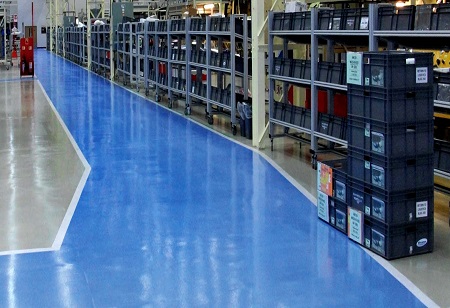Owing to the advent of modernization in all sectors and the burgeoning concern for sustainability, most of the people today are more discerning and are not looking at floors as just floors. While
Industrial flooring is used conventionally for enhancing the aesthetic appeal of the floor by providing a wide range of bespoke designs, coupled with enhancing the texture & the color, the five major factors that influence the quality of a good industrial floor include the longevity, slip resistance, durability, eco-friendliness & moisture resistance.
Ideal for utilizing in tough industrial situations
Industrial floorings are very easy and simple to maintain. They are not just long-lasting, but are resistant to several environmental variables. Industrial flooring possesses waterproof as well as slip-resistant qualities, which makes it ideal for utilizing in tough industrial situations. Industrial floorings are most commonly seen in several business settings that include manufacturing plants, fitness facilities, workplaces, etc.
Furthermore, food & beverage sector's surge in demand for industrial flooring with an aim to reduce concrete degradation throughout the manufacturing task is most likely set to drive the market for industrial flooring ahead. The rise of this industry is also related to the food & beverage industry's growth. This is ascribed to increased spending in the consumer as well as government spending on the food industry.
The market for industrial flooring is anticipated to grow in a faster pace as several rules & regulations that are related to workplace safety as well as cleanliness are implemented. According to EU regulations the floors of the food industry should always be kept clean, & thoroughly disinfected. Also, the floor material should not only be easy to clean, but also non-absorbent & durable as well.
One such type of industrial floor which has become highly significant is the concrete industrial floors and it is a part of the modern construction industry. At present, there are several types of technical solutions in the concrete floors segment. The pandemic has transformed the
customer expectations in the flooring segment and has resulted in several changes and trends.
Changes in commercial construction trends
The non-residential construction went below thirteen per cent for the first three quarters of 2020, as per the information given by First Research. Construction activities have gone down to a greater extent in the pandemic's wake, that would lead to more project delays as well as shutdowns.
Commercial flooring firms are highly dependent on the commercial construction sector, when compared to the same period a few months ago, and now the commercial flooring sales have reduced to a greater extent.
In its Leadership Outlook 2021, Meg Scarbrough from Floor Focus notes: "Manufacturers report they expect sales of commercial flooring to be flat to slightly down for the coming year and maybe into 2022, with projects undertaken this year budgeted in 2019 and with funding available to complete them. But projects are becoming less frequent, and even when they do begin picking back up, it could take time to fully recover."
Rise in interest in home renovations and sales
While there have been a fall in the commercial construction activity, there has also been a rise in house renovation projects and the home sales & nuclear-family housing construction. However, what has made home buying as well as renovating highly attractive is the fall in the interest rates. Furthermore, other factors that have influenced the consumers is that they are spending more time at home, and also the businesses have started moving to work at home arrangements.
The surge in demand for residential carpeting mostly is based heavily on home sales. As First Research noted that customers immediately after purchasing a new home are going to most likely replace the previous carpeting with new carpeting. Hence, the strong real-estate market could bode well for carpeting. And a few in the industrial flooring industry are trying to increase the profile of carpeting profile with the most important qualities such as softness, sound-dampening & comfort.
However, in the recent years, carpet market has been going down since homeowners moved to non-carpet flooring options. And, this is because of several reasons that range right from maintenance to allergen considerations. As a consequence, most of the carpet manufacturers have broadened their portfolio into non-carpet, flooring products and this is where there has been a surge in the demand that has been higher.
The road ahead
Carpet manufacturers have begun to manufacture "green" carpeting which leverages polymers that are used from renewable resources that include corn sugar. Furthermore, they are recycling plastic bottles as well as other materials for creating carpet fibers & a few reuse manufacturing scrap as the basic raw material. Decreasing process wastewater & waste-to-landfill levels are some of the other sustainability initiatives. Lastly, as the demand for more and more sustainable building factors continues to grow, it is likely that the demand for hardwood floors as well as woodwork will also continue to grow.
